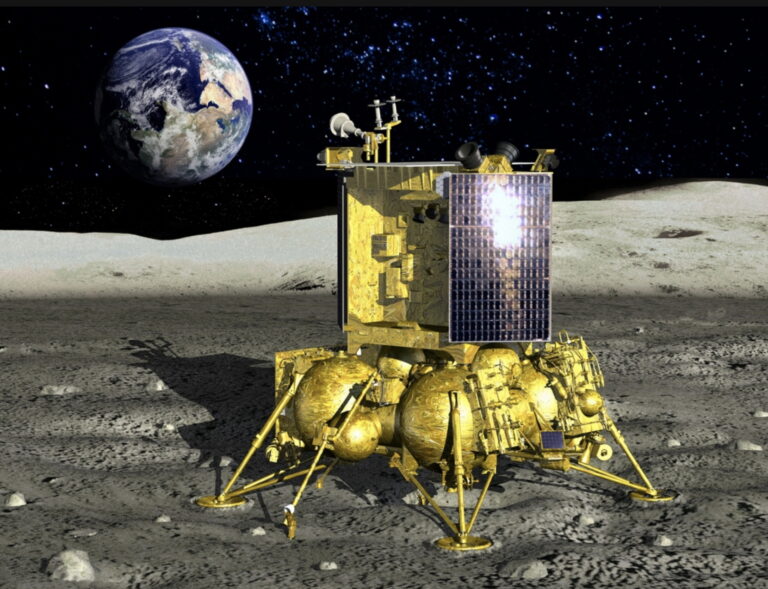In a stunning turn of events, the highly anticipated Russia mission for moon Luna 25 failed, even after 47 years of meticulous planning, the Russian space agency Roscosmos faced a devastating blow as their lunar exploration endeavor ended in failure
Amidst the array of missions aimed at uncovering moon secrets, Russia’s Luna 25 mission became a symbol of hope and ambition. However, what was intended to be a historic soft landing on the moon’s South Pole turned into an unexpected and disheartening crash.
In this blog post, we delve into the intricacies of the Luna 25 mission and examine the chain of events that led to its unfortunate downfall.
The Prelude: A Legacy of Lunar Missions
Russia’s history in lunar exploration dates back to the mid-20th century. The nation had conducted a total of 24 missions – Lunar 1 through Lunar 24 – until 1976. Fast forward to the year 2023, when Luna 25 was launched, intended to parallel India’s successful Chandrayaan-3 mission, which achieved a soft landing on the moon. The excitement surrounding Luna 25’s launch was palpable, especially since it aimed to be the first mission to land on the moon’s South Pole. But destiny has something else in mind.
Behind the Scenes: A Decades-Long Effort went into Luna 25 Mission
Contrary to popular belief, Luna 25’s journey didn’t begin in haste. Surprisingly, its planning commenced in 1990, with continuous preparation and testing taking place until 2023.
An astonishing sum, ranging from $130 to $200 million, was invested over these years. This colossal investment raised expectations for a triumphant mission. The propulsion system was meticulously developed in 2017, highlighting the extensive dedication put into the project.

The Unraveling: A Cascade of Missteps
As the mission’s launch neared, it became evident that meticulous planning had not translated into flawless execution. The pivotal moment arrived when Luna 25’s maneuvering engine malfunctioned. Ordinarily, the engine was designed to slow down the spacecraft during its approach to the moon.
Unfortunately, the engine failed to respond to commands, prolonging its burn time. A planned 84-second burn extended to 127 seconds due to an electronic glitch, derailing the mission’s trajectory.
You can also read more about how Russia’s Luna-5 misssion failed here.
A Lost Connection: Why Luna 25 failed?
The aftermath of the engine malfunction was nothing short of distressing. Multiple attempts were made to re-establish communication with Luna 25, all of which met with failure.
The mission, initially primed to uncover the moon’s mysteries, was now shrouded in its own enigma. The scientists’ valiant efforts to salvage the mission by locating and re-establishing contact proved futile.
The Lessons Learned: Soft Landings Aren’t Soft Challenges
Russia’s reputation in space missions is illustrious, boasting numerous successes. Yet, Luna 25 failed but it serves as a reminder that even well-established space agencies can encounter failures. Soft landings, in particular, are exceptionally demanding feats, often marred by unforeseen complexities. The South Pole of the moon, a sought-after location for its potential resource abundance, presents unique challenges that Luna 25 couldn’t surmount.
Conclusion: A Missed Opportunity and Valuable Insights
The crash of Luna 25 underscores the fragility and unpredictability of space exploration. The loss is not only material but intellectual, as valuable insights into the moon’s composition and potential resources are forever out of reach. While Luna 26 is in Russia’s future plans, the lessons learned from ‘Why Luna 25 failed?’ should pave the way for more comprehensive planning and rigorous testing to prevent history from repeating itself.
In a world where space exploration continues to captivate our imagination, the journey to uncover the mysteries of the cosmos remains fraught with challenges. Luna 25’s unfortunate fate stands as a testament to the dedication, innovation, and relentless pursuit of knowledge that define humanity’s quest to explore the final frontier.
Frequently Asked Questions (FAQs)
- Q1: What was the purpose of Russia’s Luna 25 mission? The purpose of Luna 25 mission was to achieve a soft landing on the moon’s South Pole and uncover its mysteries.
- Q2: How much investment went into the Luna 25 mission? An impressive sum ranging from $130 to $200 million was invested over several decades into the Luna 25 mission.
- Q3: What caused the failure of Luna 25’s manoeuvring engine? The failure was attributed to an electronic glitch that extended the burn time of the engine, altering the mission’s trajectory.
- Q4: Did Russia attempt to re-establish communication with Luna 25 after the malfunction? Yes, multiple attempts were made to regain contact with Luna 25, but they proved unsuccessful.
- Q5: What lessons can be learned from Luna 25’s crash? Luna 25’s crash highlights the challenges of achieving soft landings in space exploration and emphasizes the need for comprehensive planning and rigorous testing to prevent failures.


1 thought on “Why Luna 25 Failed? 47 Year Russia Moon Mission Ends in Dramatic Crash Landing!”
Comments are closed.